The 7 scuole grandi are religious confraternities, which played an important role in the social history of Venice. Their charitable activities included the organization of processions, the distribution of money, food and clothing to poorer members, the burial of paupers, and the supervision of hospitals. They were almost always based in monumental sites, located near the church of their patron saint. The buildings were designed by famous architects and decorated with the finest pieces of art. If you love Venice, history and art, you should certainly visit one (or more) scuola grande on your next trip.
DID YOU KNOW? The term ‘scuola’ is a typical Venetian term. In other parts of Italy, these were called ‘confraternita’ or ‘compagnia’.
In this post, I will start with some background on the history of the scuole grande. Further on, I will give details about each of the 7 scuole grandi in Venice. You can click on the titles to access the websites of the scuole grandi for more information and practical details such as opening hours.
History
All over Italy, religious confraternities were founded from the second half of the 13th century onwards. The term ‘scuole grandi’ has only been granted as from 1467 by the Council of Ten, one of the major governing bodies of the Republic of Venice. Some sources connect the 4 original scuole grandi to the ‘scuola dei battuti’, which were linked to the Flagellanti movement (known for its self-flagellation as an act of penitence). However, according to other sources, the original scuole were lay associations focused on devotion and solidarity. These are Santa Maria della Carità, San Marco, San Giovanni Evangelista and Santa Maria della Misericordia. Later on, three other scuole grandi were added to the list: San Rocco, San Teodoro and dei Carmini.
DID YOU KNOW? There were also ‘scuole piccole’ in Venice. These included artisan schools and common schools. The latter were often linked to nationality and were used to integrate the foreign merchants visiting Venice.
Each scuola was governed by elected lay officials. It was one of the few possibilities for non-noble Venetian citizens to control powerful institutions. A wide range of citizens with different backgrounds and professions joined these confraternities. Membership was limited to a maximum number and it was open to men and women. Vagrants, beggars, prostitutes, and other social outcasts were however excluded. The hereditary patriciate and the clergy were excluded from full membership, but they often played an honorary role.
The official statutes were written on precious paper in the ‘mariegola’ (mare-regola, i.e. the mother-rule) and beautifully decorated. The document didn’t only talk about the institutional aspects of the confraternity related to religion, morality, behavior, politics, economy or administration. It also instructed how the members were supposed to behave on a daily basis. They had to work hard, pray and show respect for religious rules and for the society. They would only be rewarded by the remission of sins in heaven if they followed these rules.
Even though some of the scuole grandi still fulfill their traditional role, the scuole are now also open for the public. They can be visited as a museum and are used to host events, exhibitions, concerts or seminars. It is certainly worth to add a few to your travel plan when visiting Venice. You will see from the list below that there is a scuola grande in each of the sestiere of Venice, so there is always one nearby.
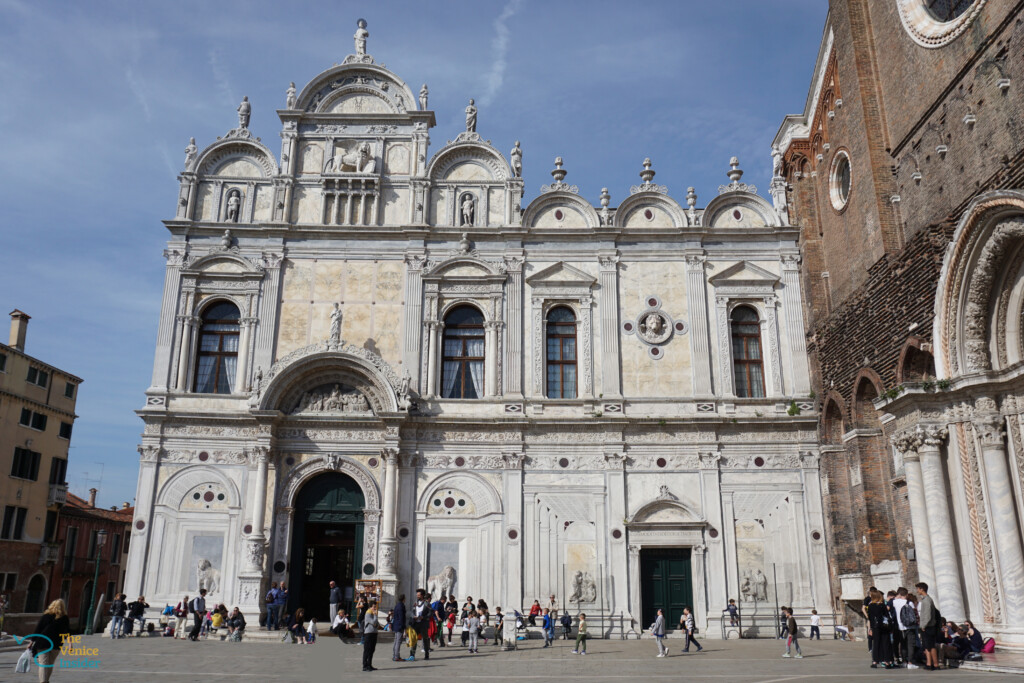
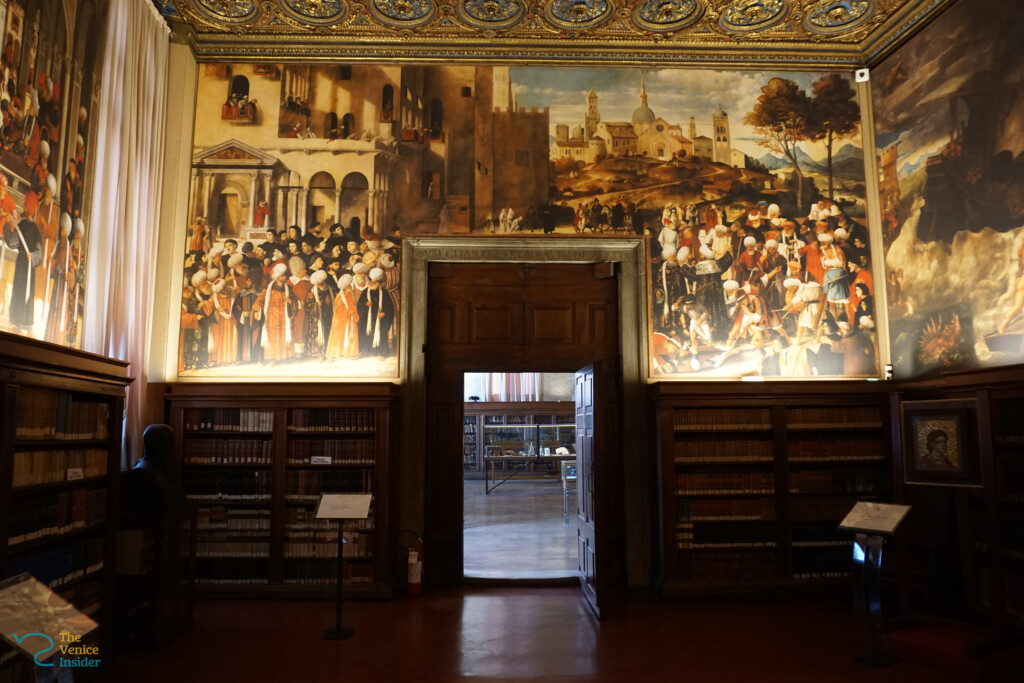
Scuola Grande di San Marco
(Castello 6777, Campo Santi Giovanni e Paolo)
This scuola grande is probably the best-known one, as it is located next to the Ospedale and the Santi Giovanni e Paolo church. It was founded by the Confraternity of San Marco in 1260. Unfortunately, the original mariegola of the Scuola Grande di San Marco is the only one which is missing at the Archives of the city of Venice. However, if you are interested, you can read the text (in Italian) on the website of the Scuola by following this link.
The confraternity moved to the current location in 1437. The original building had to be reconstructed in 1485 after a candle on the altar caused a large fire. It was designed by architect Pietro Lombardo and completed by Mauro Codussi. From the Campo Santi Giovanni e Paolo, you can admire the façade with its delicately decorated niches and pilasters, and white and polychrome marble statues. It features magnificent trompe l’œil panels by Tullio and Antonio Lombardo representing two episodes from the life of San Marco and his faithful lion.
INSIDER TIP: If you look carefully at the walls, you will notice some carvings in the stones. There are vessels at approx. 1.5 m height and a man with a heart in his hand at 30 cm height. These are not the result of recent vandalism, but were carved by Cesco Pizzigani. The old stonecutter became a beggar after his wife died and damaged the beautiful building, even though he had been part of the construction team.
In 1819, it became an Austrian military hospital and it is now a civil hospital. The building has recently been restored. It is possible to visit the interior, such as the main entrance hall, the ancient library and a medical museum. The rooms are beautifully decorated with paintings and an impressive ceiling in blue and gold colours.
Scuola Grande della Carità
(Dorsoduro 1050, Campo de la Carità)
The Scuola della Carità was also founded in 1260, in the church of San Leonardo. It didn’t have any own buildings at that time, and the confraternity rented rooms from the monastery of Santa Maria della Carità. Over time, the money from donations and commercial activities was used to buy land and buildings from the monastery. The current building dates from 1343, long before the Accademia bridge was installed in front of it.
In 1806, the Napoleonic administration disbanded many institutions in Venice including some churches, convents and scuole. The Scuola della Carità, the monastery and the church were transformed into the Galleria dell’Accademia. This museum displays the largest collection of classic Venetian art.
When you visit the museum, you can still see two rooms with original features of the Scuola Grande. The first room at the top of the staircase is the former chapter room. The room with Titian’s painting ‘Presentation of the Virgin’ was used to distribute alms and to select the young women who would receive dowry contributions.
Scuola Grande di San Giovanni Evangelista
(San Polo 2454, Campielo della Scuola)
The Scuola di San Giovanni Evangelista was founded in 1261 in the church of Sant’Aponal. In 1301, they moved to the San Stin area in San Polo, and rented some premises on the top floor of a hospice for elderly poor people. The confraternity gradually extended it as their economic and religious importance increased, and bought the premises in the 15th century. The rooms on the ground floor are more sober, while those on the first floor are nicely decorated with paintings on the ceilings and the walls and with typical Venetian marble floors.
The most beautiful room is the ‘Sala Capitolare’. During the reconstruction in 1727 and 1762, the ancient ceiling was elevated 5 metres and 12 large oval windows were added. The result is a stunning reflection of natural light on the coloured marble floor. The geometric oval and star shapes form three rosettes, a pattern which is also used on the wooden benches. Many of the paintings on the walls tell episodes of the life of San Giovanni Evangelista, while the ceiling shows a series of scenes from the book of the Apocalypse.
INSIDER TIP: When you go up to the Sala Capitolare, take a close look at the stairs. You will notice that the internal walls widen as you climb the stairs. The upper steps are almost 70 cm wider than those at the bottom. This creates the illusion that this area has more depth than it has in reality.
The Scuola organizes cultural and social events, often at international level, and can only be visited when there are no events taking place. You can find the dates for the coming month on their website.
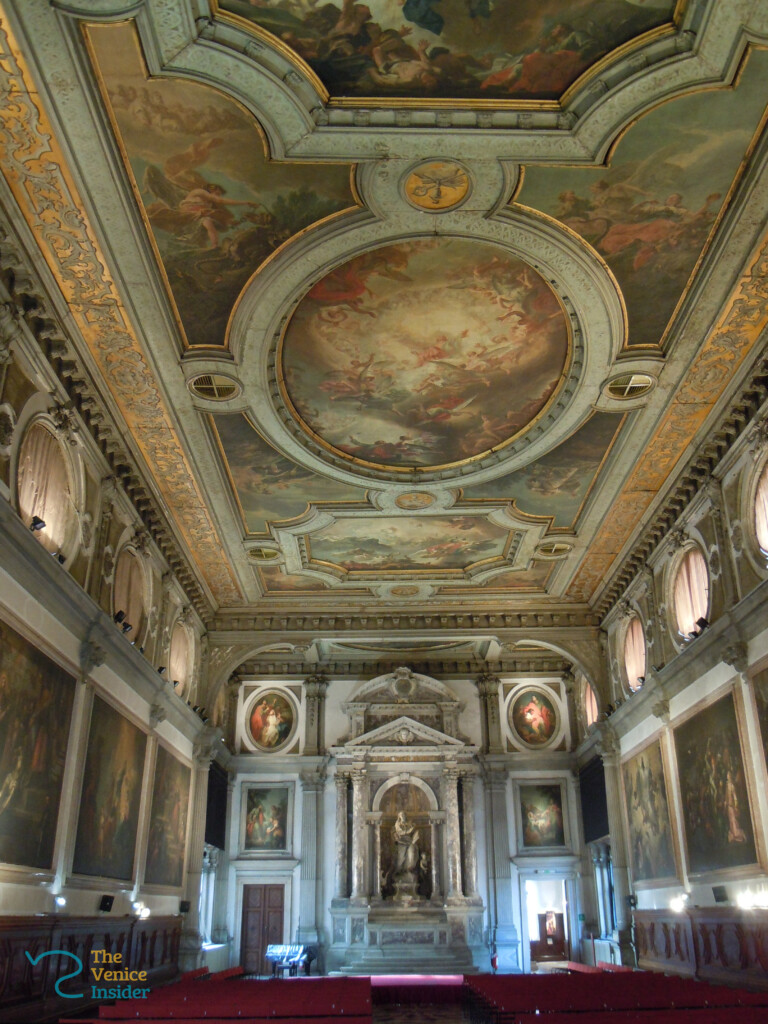
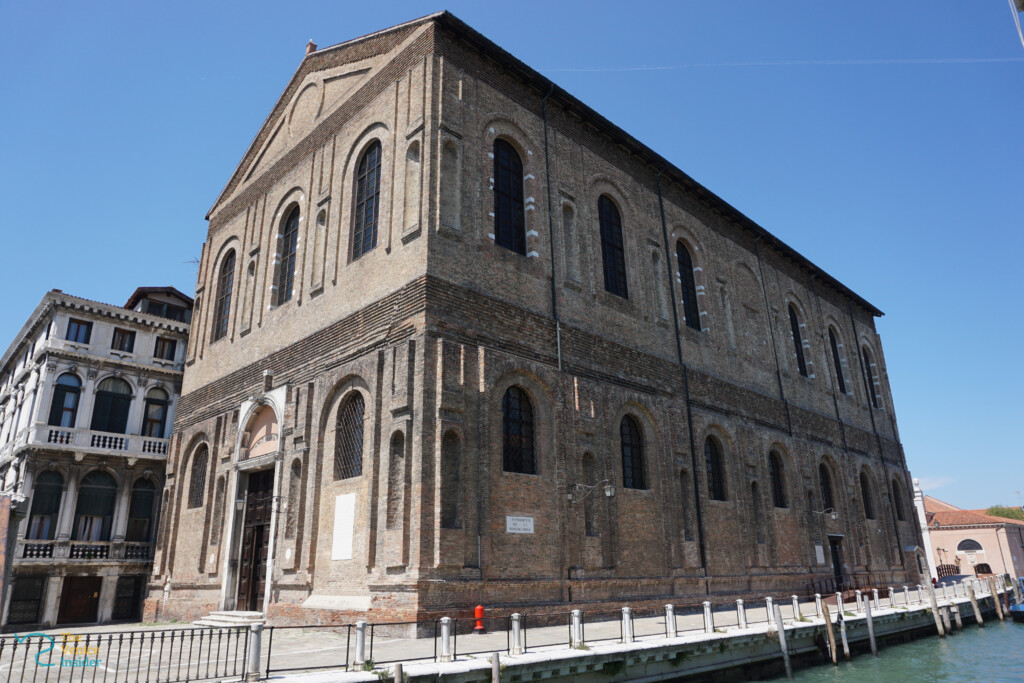
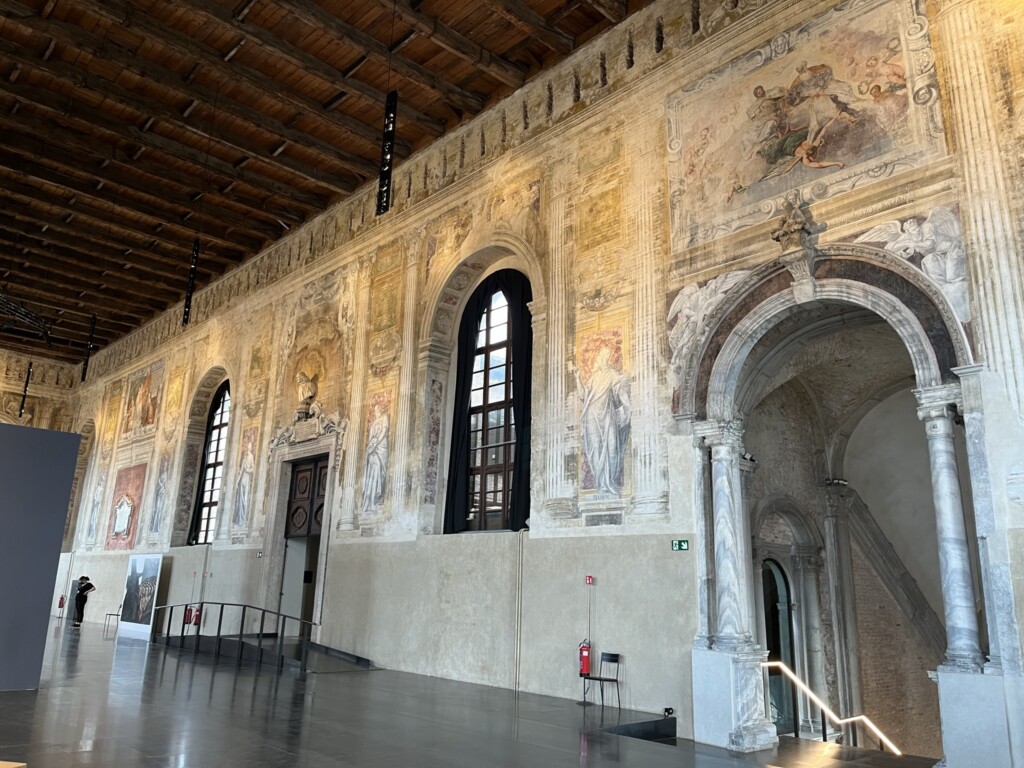
Scuola Grande della Misericordia
(Cannaregio 3599, Fondamenta Misericordia)
The construction of the original seat of the Scuola Vechia della Misericordia was started in 1308. It was expanded several times and finally reconstructed as ‘scuola nuova’ from 1532 onwards. The famous architect and sculptor Jacopo Sansovino was in charge of the whole project. He referred to the layout of Roman basilicas, while maintaining the traditional model of the Venetian schools. The interiors were richly decorated with works of Veronese, Zanchi, Lazzarini, Pellegrini, and last but not least Domenico Tintoretto, son of the famous Jacopo. The building was inaugurated in 1583 by Doge Nicolò da Ponte, but the completion of the works continued for another two hundred years.
Since the beginning of the 19th century, the Scuola has been used as military lodgings, as a warehouse, and as the seat for the State Archives. In 1914, the Costantino Reyer Sports Club transformed it into a sports centre. The first floor became the official basketball court of the Venetian team Reyer, who hosted its games at this location until the early ’80s. Every time I think about this, this still amazes me. Although, I assume it must have been very impressive for the basketball players, as well as for the spectators.
Since 2016, the renovation of the Misericordia was completed and the Scuola Grande della Misericordia can now be rented for events, exhibitions or private meetings. It often hosts exibitions during the Biennale, so if you want to visit it, check on their website if there is a public event ongoing.
Scuola Grande di San Rocco
(San Polo 3052, Campo San Rocco)
The Scuola Grande di San Rocco was founded in 1478. It was first based on an undeveloped piece of land behind the monastery of the Frari, but they quickly moved to San Samuele and then to San Silvestro. Thanks to the popularity of San Rocco, the patron saint of plague victims, the confraternity expanded rapidly and became the richest scuola of the city. In 1517, a new monumental headquarter was built to reflect their grandeur and it was sumptuously decorated with art. In 1789, the Scuola received the title of ‘arch-confraternity’ from Pope Pius VI.
Tintoretto worked more than 20 years at the Scuola (1564-c1588). He painted more than sixty episodes from the Old and the New Testaments for the different rooms. If you want to admire them one by one, you will have to take your time during your visit.
DID YOU KNOW? Tintoretto got the job because he took everyone by surprise in a competition amongst the best painters of Venice. Instead of delivering a drawing proposal as requested, he actually painted San Rocco in the centre of the ceiling. He said that if they did not want to pay him for the work, he would donate it to them. The Scuola accepted the gift, and he has been the ‘house painter’ ever since.
The Scuola Grande di San Rocco can be visited daily, while the Scoletta (the former scuola) is used for temporary exhibitions. It is a unique site, which combines a lot of history and art, and is certainly worth a lengthy visit.
Scuola Grande di San Teodoro
(San Marco, Campo San Salvador)
Dedicated to the first patron saint of Venice, the confraternity of San Teodoro was founded in 1258. The members were mainly merchants and artisans. The Scuola was first based at the Agostiniani priests before it moved to the San Salvador church. It was originally a scuola piccola and it was granted scuola grande status in 1552. The construction of the current building started in 1579 by the architect Tommaso Contin and was finished in 1613. Throughout the 17th century, the building was enlarged and decorated with paintings by Vassilacchi, Jacopo Palma il giovana, Balestra and Bassano.
DID YOU KNOW? San Marco was not the first patron saint of Venice. It was San Teodoro (or Todaro in Venetian dialect). You can see his statue on one of the two columns at the San Marco square. The other column is dedicated to San Marco. The area between the two columns was used to kill death sentenced criminals. Venetians will therefore avoid walking between these columns. There is even an expression for it ‘trovarsi tra Marco e Todaro’ (you are in between Marco and Teodoro), which means that you’re in serious trouble.
The Scuola di San Teodoro began as a charity offering education and training before it became a warehouse. Afterwards, it had different roles such as a dormitory for homeless, an archive and a movie theatre. In 1960, the Scuola was reconstructed and it is now used as a venue for cultural events such as exhibitions, meetings and concerts. Since 1999, I Musici Veneziani perform their concerts in the beautiful setting of the Scuola Grande di San Teodoro.
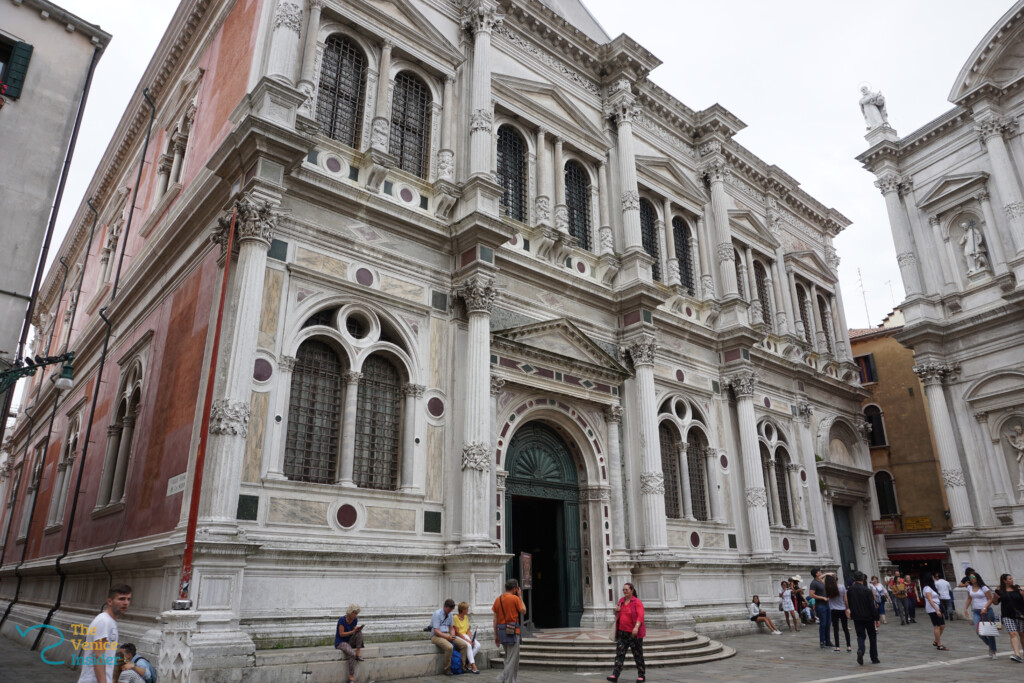
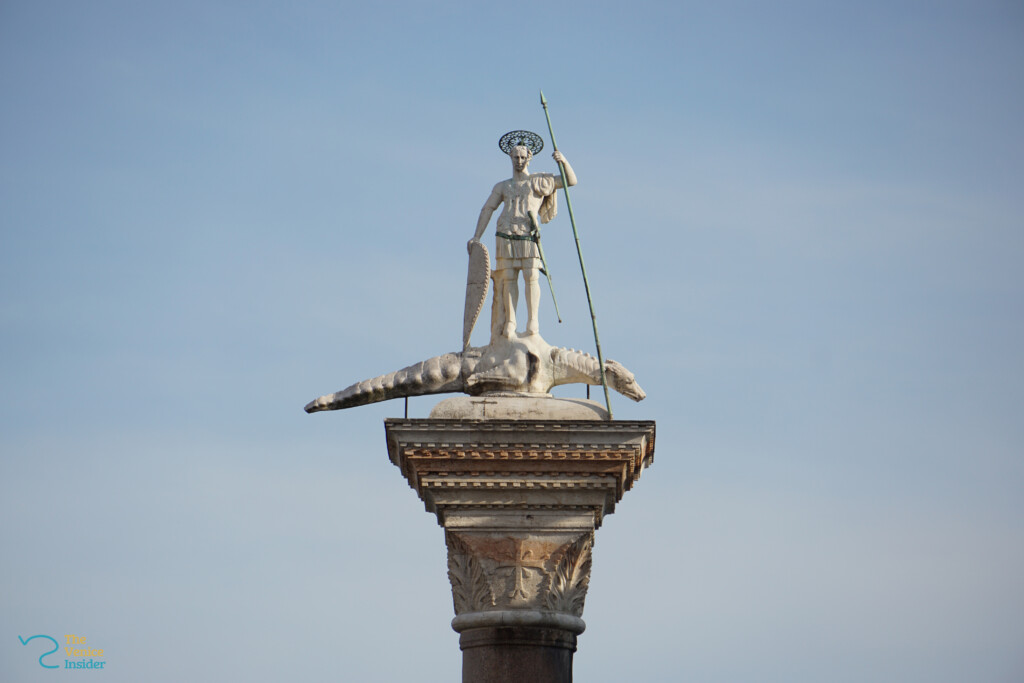
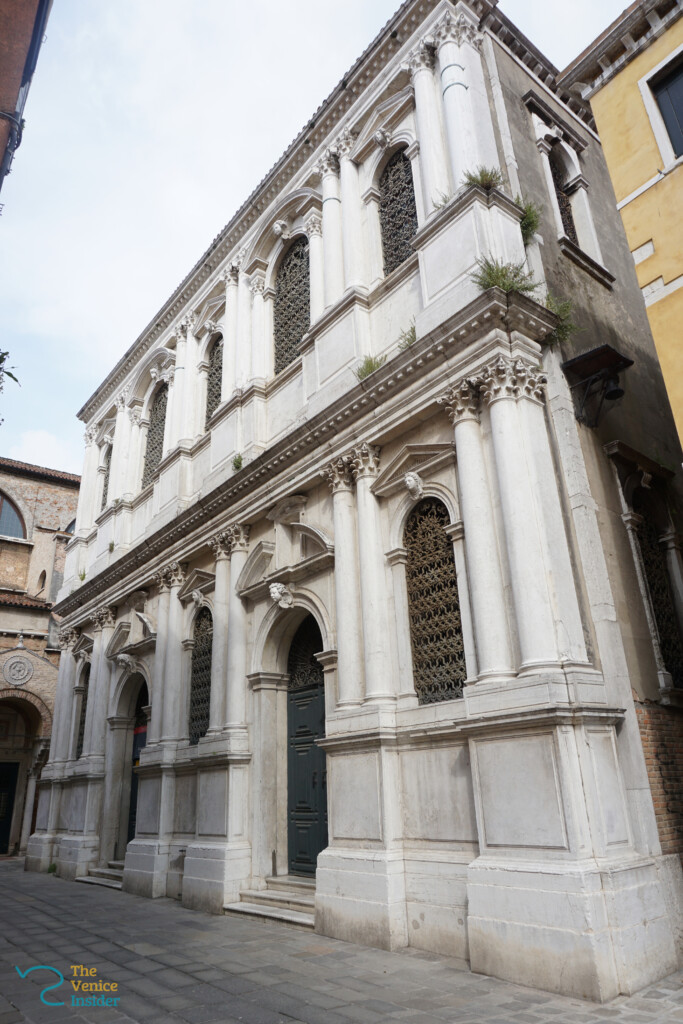
Scuola Grande dei Carmini
(Dorsoduro 2616-2617, Campo S. Margherita)
The Scuola dei Carmini was founded in 1594 under Doge Pasquale Cicogna. It was the last to be recognized as a scuola grande in 1767. Initially, they had very basic premises with only an altar in the Carmini church and a room in the monastery. In 1625, the Scuola started to build its own site, designed by the architects Caustello and Longhena. It took until 1636 before it was finished.
The original antique furnishings inside the halls of the school have been entirely preserved. These consist of important oil paintings, rich stucco ceilings and original embroidered and carved wood. The paintings include nine ceiling canvases by Giambattista Tiepolo. They depict the cardinal and theological virtues and other attributes of the Spirit and refer to the Virgin Mary.
This is the only scuola who has its origins in a lay congregation for women, known as ‘Pizzocchere dei Carmini’. The sisters of the confraternity wore the scapular as a distinctive sign, which they made themselves and distributed to the devotees as an object of Marian devotion and protection. The scapular is made of two rectangular pieces of fabric with the images of the Blessed Virgin and Christ, held together by a small cord that hangs around the shoulders.
The Scuola Grande dei Carmini is still active today. It can be visited daily and there are also concerts organized from time to time.
These 7 scuole grandi are an important element in the history of Venice and interesting landmarks for a visit. Don’t forget to add them to your list for your next visit.
Enjoy your visit!
